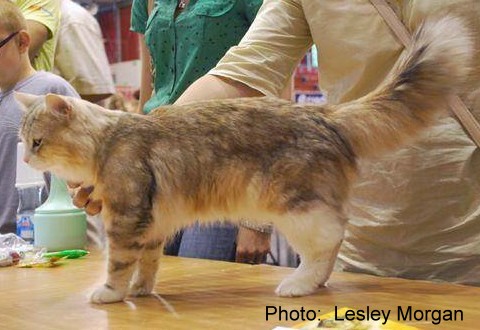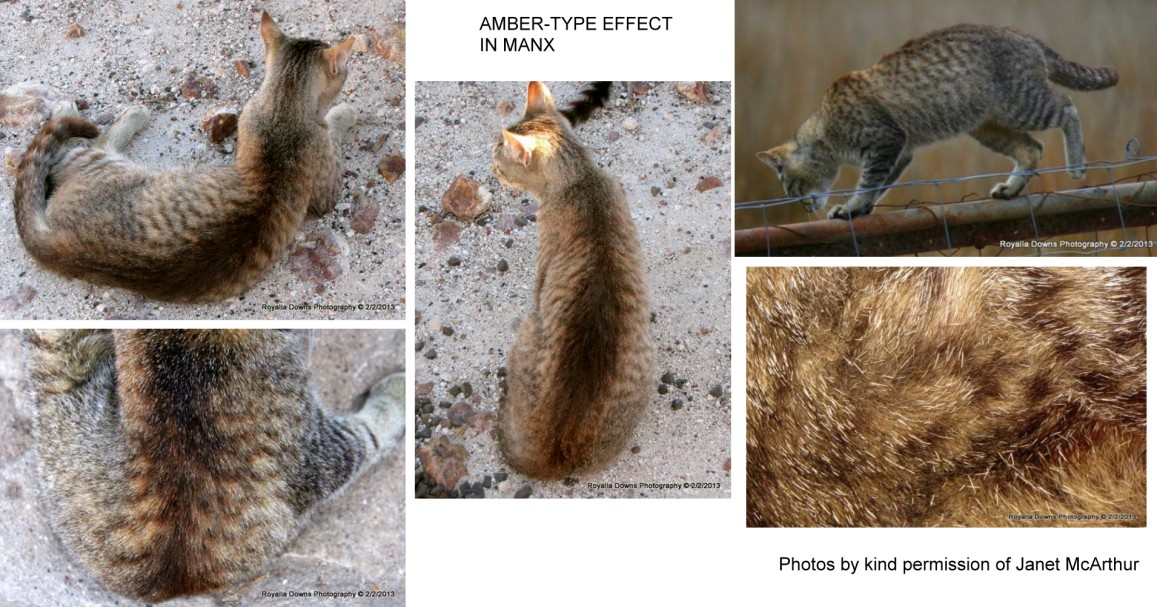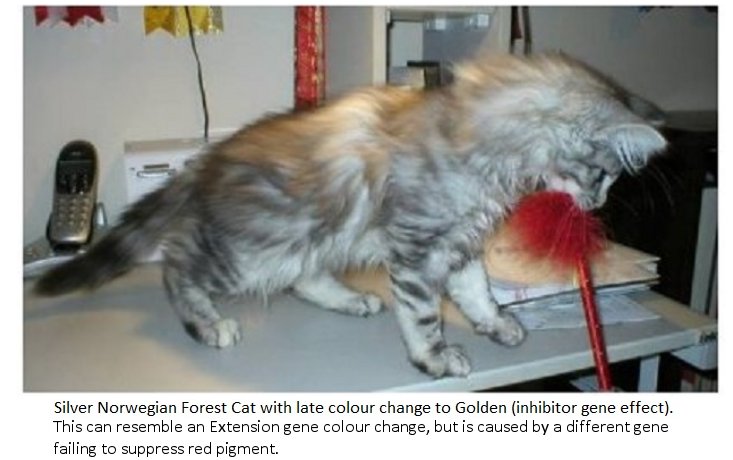
EXTENSION GENE: COLOURS RESEMBLING AMBER AND RUSSET (PSEUDO-GOLDEN, BIMETALLIC [SEAL SEPIA] AMERICAN SHORTHAIR)
The ancestors of the domestic cat were nondescript black/brown striped tabbies. Over the centuries, mutation produced a wide array of colours based on 2 different pigments. Eumelanin gives the blacks, browns and blues while phaeomelanin gives the reds, fawns and creams. A few other genes give further variations on those colours such silvers, colourpoints and solids/selfs. Mutations continue to occur and unexpected colours also turn up due to inbreeding where recessive genes, hidden for generations, start showing up.
Extension gene mutations cause the coat colour to change from a black or blue colour to a reddish or golden colour as the cat matures.
Extension Gene: Amber Norwegian Forest Cats - Late Colour Change Gene
Extension Gene: Carnelian (Copal, Serdolik) Kurilian Bobtails (Extension Gene)
Extension Gene: Russet Burmese, Mandalay, Asian Group - Late Colour Change Gene
There are two different pigments in cats:
Eumelanin (the black based colours) and phaeomelanin (in "golden tabbies," rufism and red-based colours). Some out-dated texts refer to a third pigment called "trichochrome," but this is a component part of phaeomelanin, not a separate colour. All amber and russet cats are genetically black. They have black skin, but a yellowish coat. Light amber cats are genetically blue (dilute of black)
Prior to the emergence of amber, and then russet, there had never been any scientific evidence of a yellow recessive mutation (e) in the extension gene in cats. The Extension gene contributes to the Melanocortin 1 Receptor (MC1R) protein pathway. MCR1 is necessary for producing eumelanin. If the MCR1 receptor is damaged (mutation) it can't make eumelanin and makes phaeomelanin (yellow) instead. The Agouti allele also allows phaeomelanin production in black-based cats even if the MC1R receptor is undamaged; that's why agouti black-based cats have a yellowish background and dark markings while non-agouti black-based cats only produce eumelanin and are solid colour. Because of this, non-agouti amber/russet (solid amber/russet) show faint tabby patterns.
The unmutated version of MC1R allows the black pigment to extend from the skin into the hair (hence "extension" gene). The mutated MC1R does not allow black pigment to extend into the hair, so the skin is black, but the hairs are reddish.
AMBER-LIKE COLOUR IN SIBERIAN AND KURILIAN CATS
There is a known golden-type colour found in Siberian cats called "sunshine" and a dominant extension gene mutation in Kurilian Bobtails called copal/carnelian. The amber-like colour seen in these breeds has pink, rather than black, nose leather and paw-pads. Brown (black) tabby copal/carnelian Kurilians are born with reddish tones and eventually become red tabby adults ("false reds") with black tail tips. Sunshine Siberians don't go through the same type of colour change seen in Russet cats which also have pink nose-leathers and paw-pads. Sunshine silver (nicknamed "bimetallic," because both gold and silver/silvber-gilt are visible) describes some Siberian silver tabbies that turn golden in a rather patchy fashion. Unlike the amber gene, the colour change does not start on the back and work downwards, but seems distributed throughout the coat. See Carnelian (Copal, Serdolik) Kurilian Bobtails (Extension Gene) and Sunshine and Sunshine-Silver ("Bimetal") Siberians
Mis-identification of these cats as "amber" (EMS code "nt") causes confusion. These cats are born to golden tabby parents (EMS code "ny"). This causes the misconception that ny + ny (black-golden + black-golden) gives nt (amber). This is incorrect because "ny" is due to the agouti gene and wideband effect, but "nt" is caused by the extension gene. There is also the misconception that "ny" + "ns" (black-golden + black-silver) gives bimetallic. Bimetallic appears linked to the "sunshine" gene gene.

PLATINUM
The platinum effect is found in some lines of Silver Persian/Chinchilla Longhair. In 1986/7 a shaded silver female (Kelley Lane Contessa of WeANDE) from a brother-sister mating changed from pure silver to pale golden at 10 - 12 months old. The parents were a shaded golden and a shaded silver. ; these were full siblings. An adult Silver Persian from England (Lynchard Silver Shadow) was exported to Australia and also turned golden. Many of the cats had no golden in their ancestry. At first it was dismissed as an unavoidable genetic fault where silver was incompletely dominant and did not hide the recessive golden colour. For full information and pedigrees see "Platinum" Persians - A Late Colour Change Gene
AMBER-TYPE EFFECT IN MANX
An amber-type effect has also been seen in a Manx cat. Janet McArthur bred a male Manx (a longy i.e. with tail) that was born an ordinary black/brown mackerel tabby without much rufousing, as was his sister. In addition, the male had white ticking at the tips of his hair. As the male grew, his stripes faded out and became spots while the black markings also changed from black to a burnt red-brown colour and his white ticking became smaller. The change from stripe to spots was probably an optical effect caused by the change from black to red-brown. His dorsal line became a burnt golden brown, and the background colour was similar to a washed out sorrel colour (sorrel is a colour found in Abyssinians).
There are a few oddities in his ancestry. His mother, Pearl, was a black Manx and his sire was a normal black/brown tabby from the same black Manx mother. The inbreeding was accidental, and may have brought out a recessive gene. Pearl was born to a black/red tortie (carrying dilute and colourpoint) and a red van-pattern sire; this pairing should not produce solid black females so, barring an anomaly in her sire's germ line, Pearl may be a tortie where the red has not been expressed in the coat. Pearl has also produced a kitten that changed from black with white ticking at the hair-tips, to black smoke and then to solid black without ticking.

BIMETALLIC-TYPE EFFECT IN A SILVER TORTIE AMERICAN SHORTHAIR
Sometimes the colour appears to change as the fur grows and may not be due to an extension gene mutation. This American Shorthair is genetically silver tortie tabby with sepia (Burmese) colour restriction makingher a seal silver tortie-tabby. She was born dark-coloured and the golden areas became prominent later. The father is a silver classic tabby (i.e. black marked) and the mother is cameo (red-silver) and white. Although the American Shorthair is accepted in all colours and has an open studbook and has been crossed with the Burmese in the past. She was bred by Alhattab cattery in Kuwait and is CFA registered.
The inhibitor gene is less effective on red pigment than on black pigment, which means that a silver tortie can seem to have a mix of silver and golden background colour. The apparent brown colour could be due to an even mingling of red and black with a lot of rufousing, rather than clearly defined red and black areas. The father appears to have some tarnish (rufousing). However the development of the colour and the visual suggestion of a pointed cat is unusual. These come from Russian lines and an imported American stud that appears to carry sepia.

To eliminate tabby markings in the Shaded Silver American Shorthair, other breeds were added. Wayne Park used a chocolate point Siamese to introduce the agouti (ticked) tabby pattern gene to get rid of excessive leg barring and clear up the coat. This meant that pointed cats and chocolate-silvers occurred. Other breeders use Burmese to introduce the ticked tabby pattern, but this could give the red colours a "muddy" appearance.
Another source of Burmese colour restriction in the American Shorthair was the breeding programme for the Bombay which used Brown Burmese and Black American Shorthairs. After Nikki Horner established her Shawnee lines, other breeders founded additional lines to ensure genetic diversity. It’s likely that some offspring went into either the Burmese gene pool or the American Shorthair gene pool (the latter had an open studbook to accept foundation cats of supposedly “unknown” ancestry) depending on which they most closely resembled.
PSEUDO-GOLDEN
Over the years, there have been accounts of pure silver Persian kittens turning to a pale golden colour as they mature. This often began with yellowish "tarnish" or cream spotting appearing in the coat of a shaded silver or chinchilla cat. Reddish hairs first appeared on the spine, face or paws, and progressed through a yellowing of the undercoat. Chinchillas derived from chinchilla-to-chinchilla matings sometimes exhibited reddish or golden hair along their spines which was attributed to incomplete dominance of the golden gene "breaking through" in the coat. Some silver kittens were, when 2 or 3 years old, very definitely pale golden adults. Offspring born to such cats were born as silvers, showing the "golden" cat was genetically a silver, but some of those offspring also had a tendency to turn golden at about 2 or 3 years old.
Silver and chinchilla cats have been selectively bred to eliminate (as far as possible) polygenes that would modify the colour's purity. The silver should, therefore, be devoid of genes that cause cream, yellow and red pigment. Yellow denotes the technical term for the pigment granule which produces all of these colors. Polygenic complexes have plus and minus polygenes that influence the trait. Diligent breeding resulted in accumulations of either plus or minus polygenes in a specific breed or colour. However, these polygenes are carried on different chromosomes and inherited independently of each other.
In silvers, the inhibitor gene means the round granules of eumelanin (black) are absent from most of the hair shaft and are clumped near the tip. Being incompletely dominant, the effect ranges from shaded silver through to tipped (chinchilla). In normal goldens, the granules of the yellow pigment, phaeomelanin, are possibly influenced by the recessive form of the inhibitor gene and/or a wide band factor. However, the silvers that turn into goldens don't have any phaeomelanin. Instead, these "pseudo-goldens" turned out to have an additional mutation that caused their eumelanin granules to be elliptical rather than round and to show as a beige or pale golden colour. These mutant granules are not completely eliminated from the hair shaft, but are smeared along it, causing a pale golden undercoat. They are also clumped at the tip to give the shaded or tipped effect.
Eumelanin is usually described as "black", but is actually a deep brown (sepia) that appears black to our eyes. As the eumelanin granule becomes elongated, it appears paler and more reddish-brown or dark-yellowish-brown. The concentration of the mutant eumelanin granule on the hair shaft gives colours ranging from copper-brown through apricot to reddish honey, all with darker tips. The mutated eumelanin gene has been described as a "late colour change" gene for obvious reasons. Its mode of inheritance not fully understood. It is also possible that some apparently golden-from-birth Persians may be pseudo-goldens and can have silver kittens - generally considered an impossibility as silver is dominant over normal golden and cannot be carried as a recessive (though silver can reoccur as a spontaneous mutation).

This Norwegian Forest Cat was bred by Yve Hamilton Bruce from a silver mackerel tabby female (imported from Denmark) and a classic red tabby and white male. The result was 1 silver tabbies and 2 silver tabbies with white. At just over 3 months old, this silver and white tabby male developed a large patch of bright red hair on his back (as shown) which continued to spread until he was completely golden. Though similar to an amber colour-change, this is an unusual silver-to-golden change related to the inhibitor gene. Though it superficially resembles amber, this particular colour change is related to the inhibitor gene.